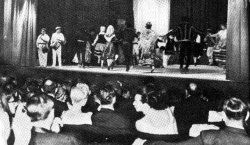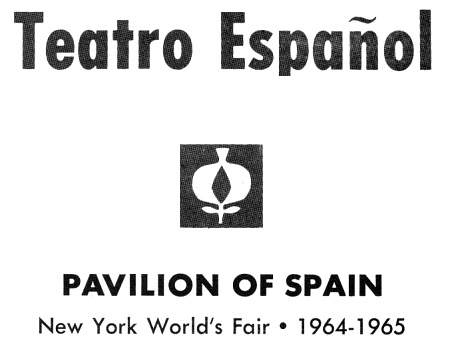
- Spain presents four kinds of
shows in the pavilion: folk-dancing, music, flamenco dancing
and films about everyday life. The great richness of Spanish
folk-songs and dances are revealed by the three programs of the
Groups of Coros y Danzas (Songs and Dances) with their
amazing variety. Flamenco is genuinely represented by the Manuela
Vargas group which had such a triumphant welcome in the first
part of the Fair. Spanish music comes to life in the guitar notes
of Diaz Cano or in the strings and many throats of the student
choirs. The showing of documentary films such as Espana insolita
(Unusual Spain) and slides about the Spanish land and people
complete the shows on the program.
|
-
COROS
Y DANZAS
OF SPAIN
- The groups that form this wonderful
undertaking called Coros y Danzas of Spain (Songs and
Dances of Spain), have carried out of recent years one of the
most beautiful tasks that can be done: find, discover, interpret
and reveal to all, that immense Spanish treasure of folk songs
and dances, and take them to every corner of the Motherland as
well as carrying them abroad for the joy and admiration of all
the countries of the world.
|
- Wherever we go, dancing is an
art; in Spain it is a demonstration of life. Here dancing has
kept its primitive spontaneity; it is not the mechanical repetition
of steps invented by any teacher but the gay overflowing of an
untamable vitality.
-
- On the Spanish Coros y Danzas
there have been many opinions: Theirs is a primitive art,
with all its original sweeping beauty and starting point for
all lovely things... In all my long life dedication to these
things, I can assure that there has never been anything so successful
as the Coros y Danzas of Spain. Coronel W. de Basil,
Creator of the Montecarlo Ballets.
|
-
The Coros y Danzas
in the theatre of the Pavilion.
 |
|
-
FLAMENCO
by MANUELA VARGAS from Sevilla
|
|
- Manuela Vargas is a bronze beauty,
all music, agility and rhythm. She possess that mysterious, indefinable
quality known in Spanish as garbo; the most agile and
elegant occupant of space. She does not dance alone: There are
hundreds of Manuela Vargas dancing -branches, shadows and repetitions
of herself- together with her companions the air and the light...
All the angels and spirits of Andalusia accompany that bronzed
angel, spirit of grace, called Manuela Vargas.
|
-
MANUEL
DIAZ CANO Guitarist
- Manuel Diaz Cano is a really
representative concert guitarist of Spain. Diaz Cano toured all
through South America giving concerts and went also around Middle
East, Italy, Switzerland, Portugal, Spain and Morocco, where
he settled.
|
- He made records with Durium
in Milan, with Decca in London. His original works are
published by the Union Musical in Madrid.
-
- In the numerous concerts Diaz
Cano gives in the Spanish Pavilion, he will include classical
works but he will especially play Spanish music.
-
- Manuel Diaz Cano is worthy of
great respect; apart from being an expert in technique, master
of all the secrets of his instrument, he is a profound interpreter,
of the classic works as Spanish folklore. He won a resounding
success during his concert at the Conservatoire.
|
|
-
Source: Teatro
Espanol Program

| LET'S MEET SPAIN |
|
An entirely new entertainment technique is being used to produce
LET'S MEET SPAIN. It is a computer-programed, electronically
synchronized, three-screen spectacular conceived by photographer
Martin Swithinbank. It is a half-hour showing of 750 color transparencies
which appear in simultaneous groups of three. The sound and music
were recorded at 30 location is Spain.
Photographed, directed and produced by Martin Swithinbank.
Audio Engineer: James J. Hurley
|
|
PROGRAM
| 1. |
Zapateado introduction |
|
|
| 2. |
The Churches and
Religion of Spain |
|
|
(a) Semana Santa
in Seville |
|
(b) Fiesta de San
Fermin in Pamplona |
|
|
|
|
|
| 9. |
The Folk Costumes
of Spain |
|
| 5. |
The Noble Art of
Bullfighting |
|
|
|
|
| 11. |
The Landscapes and
Seascapes of Spain |
|
|
|
Every day, 10 A.M. to 12, the Teatro Espanol presents documentary
films portraying every aspect of Spain and Spanish life. |
|
|
- Source: 1965 Guide
- Pavilion of Spain

|
|